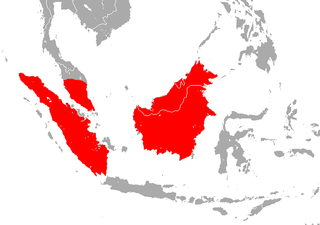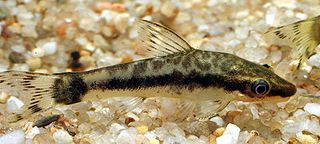
Hypoptopoma is a genus of armored catfishes native to South America.

The fringed long-footed myotis is a species of vesper bat in the family Vespertilionidae. It is found in China, Taiwan and Hong Kong.

The Burmese whiskered myotis or Burmese whiskered bat is a species of vesper bat. It is found in China, India, Myanmar, Laos, and Vietnam.

The Borneo roundleaf bat or Bornean leaf-nosed bat is a species of bat in the family Hipposideridae. It is found in Borneo, Sumatra and Peninsular Malaysia. Hipposideros sabanus is a synonym of this species.
The Oriental serotine is a species of bat in the family Vespertilionidae. It is widespread and found throughout Asia.
Mittermeier's Tapajós saki is a disputed species of saki monkey, a type of New World monkey. It is endemic to west-central Brazil.
Cyanea calycina is a flowering plant in the Campanulaceae family. The IUCN has classified the species as critically endangered. It is native to the Hawaiian Islands. An example is being monitored with a plant cam.
Chelonodon laticeps, known as the blue-spotted blaasop, is a species of pufferfish in the family Tetraodontidae. It is native to the Indian Ocean, where it ranges as far south as the mouth of the Xora River in South Africa, and the Pacific Ocean, where it is known from Papua New Guinea. It is a tropical species found in quiet, weedy areas of marine and brackish waters. It reaches 20 cm in total length. ITIS lists this species as a member of the genus Chelonodontops, although WoRMS and FishBase both include it within Chelonodon.

Chelonodon patoca, known as the milk-spotted pufferfish or the milkspotted puffer, is a species of pufferfish in the family Tetraodontidae native to the Indo-Pacific. It ranges from East Africa to the Admiralty Islands, New Britain, the Trobriand Islands, China, and northern Australia. It is a tropical species that occurs in coastal waters, lagoons, estuaries, and rivers. While it does enter fresh water, the species does not occur more than a few kilometres from the sea. It is often seen in schools which sometimes enter freshwater streams. It is usually found at a depth range of 4 to 60 m and reaches 38 cm SL. The species is reportedly considered a delicacy in Japan. ITIS lists this species as a member of the genus Chelonodontops, although WoRMS and FishBase both include it within Chelonodon.
Chelonodon pleurospilus, commonly known as the blaasop beauty, is a species of pufferfish in the family Tetraodontidae. It is a marine species endemic to South Africa, where it ranges from the mouth of the Xora River to Durban. It reaches 20 cm in total length. ITIS lists this species as a member of the genus Leiodon, although WoRMS and FishBase both include it within Chelonodon.
Pao palustris is a species of pufferfish in the family Tetraodontidae. It was described in 2013 as Tetraodon palustris by Pasakorn Saenjundaeng, Chavalit Vidthayanon, and Chaiwut Grudpan from the Mekong basin of Thailand. FishBase lists this species as a synonym of Pao brevirostris, although ITIS lists Pao palustris as a valid species.
Torquigener marleyi is a species of pufferfish in the family Tetraodontidae. It is a marine species known only from South Africa, where it occurs near the Tugela River in KwaZulu-Natal. FishBase lists this species as a synonym of Torquigener balteus, although ITIS and WoRMS list it as a valid species.
Hypoptopoma guianense is a species of catfish in the family Loricariidae. It is known from the Essequibo and Nickerie drainages in northern South America. It reaches 6.4 cm SL. The specific epithet of this fish derives from its presence in Guyana.
Hypoptopoma gulare is a species of catfish in the family Loricariidae. It is native to the Amazon and Ucayali basins in South America. It reaches 10.5 cm SL. It is sometimes seen in the aquarium trade, where it is referred to as the giant otocinclus, despite not belonging to the genus Otocinclus.

Hypoptopoma inexspectatum is a species of catfish in the family Loricariidae. It is native to the Paraná and Paraguay basins in tropical South America. It reaches 7.1 cm SL.
Hypoptopoma psilogaster is a species of catfish in the family Loricariidae. It is native to South America, where it is known only from the Amazon basin. It reaches 7 cm SL.
Hypoptopoma steindachneri is a species of catfish in the family Loricariidae. It is native to South America, where it occurs in the Amazon River basin. It reaches 10 cm SL.

Hypoptopoma thoracatum is a species of catfish in the family Loricariidae. It is native to South America, where it is known from the Amazon River basin. The species feeds on algae and reaches 8 cm in total length.

Otocinclus macrospilus is a species of catfish in the family Loricariidae. It is native to South America, where it is known from the Amazon River basin. The species reaches 3.5 cm SL and is found in the aquarium trade, where it is sometimes referred to as the common otocinclus or dwarf otocinclus, both of which can lead to confusion with other Otocinclus and Macrotocinclus species.

The Bornean whiskered myotis is a species of vesper bat endemic to Borneo.







